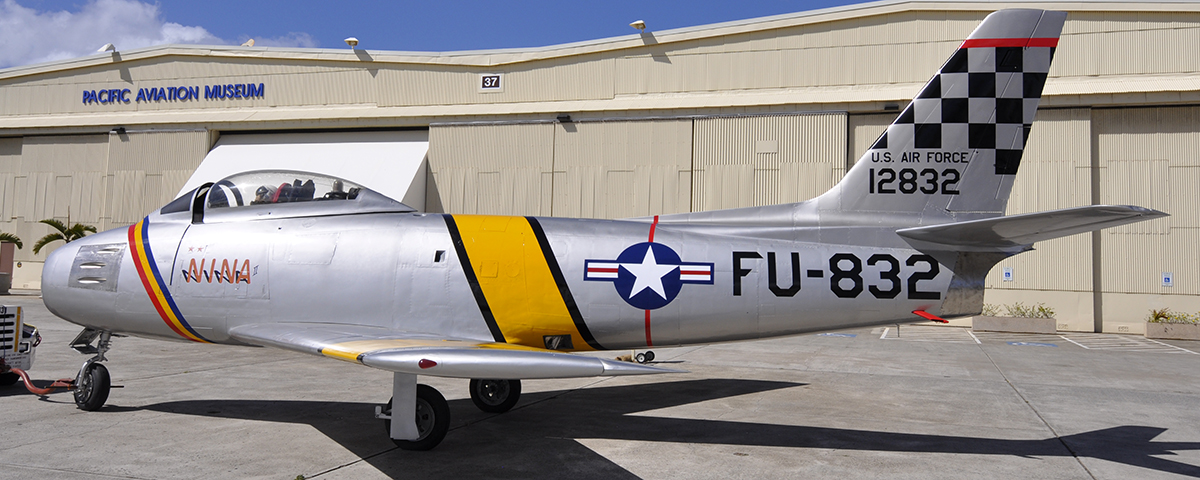Korean War rivals face off in the Pacific Aviation Museum’s new MiG Alley exhibit.
In the opening round of Admiral Isoroku Yamamoto’s attack on Pearl Harbor, Japanese dive bombers hit Ford Island Naval Air Station, in the harbor’s center. One of the first bombs mangled a hangar that held Consolidated PBY flying boats. By the time the attack ended a few hours later, 33 of 70 aircraft on Ford Island had been destroyed. But most of the hangars survived, and today two, Hangar 37 and Hangar 79—both still bearing bullet holes and scorch marks from the December 1941 attack—house the Pacific Aviation Museum.
The focal point at Hangar 79 is a new MiG Alley exhibit, opened in June 2010 on the 60th anniversary of the beginning of the Korean War. The exhibit features an F-86E Sabre and a MiG-15, squaring off above a partial re-creation of a Korean War air base. Amazingly, museum volunteers assembled the exhibit in just three months. In a bit of historical synchronicity, the F-86 is painted in the colors of Colonel John W. Mitchell’s Sabre in Korea. Mitchell also fought in World War II, leading the April 18, 1943, Lockheed P-38 flight that shot down Admiral Yamamoto’s transport plane.
The museum’s F-86E, no. 51-2841, saw combat in Korea but didn’t down any MiGs. It served as a gate guard for the Hawaii Air National Guard for almost 50 years, and, standing only 150 feet from the Pacific Ocean, suffered extensive corrosion damage. Just three months before the exhibit’s unveiling, the museum tasked its restoration crew, consisting mostly of Hawaii ANG retirees, with restoring the fighter’s exterior, an assignment that assistant curator Jim Goodall says typically takes a year and a half.
“We worked seven days a week, not quite around the clock,” says Goodall. “Our volunteers painted the Sabre, and also put on all the stenciling, using original artwork found in Squadron/Signal hobby shop publications and also Warren Thompson’s book F-86 Sabre Aces of the 51st Fighter Wing. The Sabre has stenciling and markings that an operational Sabre had in the Korean War.”
That operational F-86E-10, no. 51-2832, was flown by Colonel Mitchell, commander of the 51st Fighter-Interceptor Wing from June 1952 to May 1953—hence the faithfully reproduced tri-colored commander’s stripe on the nose. He nicknamed it Nina II. After Mitchell, several pilots of the 16th and 25th Fighter-Interceptor squadrons flew 2832, including Major John C. Giraudo, who used it to shoot down two MiGs on May 13 and 14, 1953. Giraudo was himself shot down in Nina II on June 16, 1953, ejecting over MiG Alley. He finished the war in a POW camp; the plane was destroyed.
Volunteers had a tough job transforming the derelict gate guard into Nina II.“The most critical part of restoring the Sabre was getting rid of the corrosion,”explains Goodall.“There were parts of the plane you could stick your fingers through, and everything behind the skin was rotted out.” First, Goodall and his team took the Sabre outside and blasted it with a high-pressure washer. After hosing out bird droppings, bird nests, sand and salt deposits, they sanded the F-86 to remove its old paint, and replaced the corroded sections with new skin. The process was labor intensive, to say the least.
“Once we had all the structure repaired, we took parts from our F-86L Sabre to finish the exterior,” continues Goodall. “We mocked up the ejection seat and instrument panel—they are not original. We then took it to the paint booth and applied a base coat, primer, silver paint and clear coat. Finally, we added the detailed, authentic insignia.” For this particular F-86, that included the yellow bands on fuselage and wings, common to all Sabres in Korea starting in early 1952; the blackchecked tail pattern of the 51st FIW (the “Checkertails”); and the red band on the tail fin, belonging to the 25th FIS.
The Sabre’s MiG-15 adversary came from Hickam Air Force Base fully restored. According to Charles Nicholls, historian for the Pacific Air Forces at Hickam, in 2001 the Hawaii ANG acquired the MiG from the boneyard at Davis-Monthan Air Force Base in Arizona and flew it to Hickam in a C-130. The 15th Maintenance Squadron assembled and painted the plane to resemble a typical MiG-15 that flew combat patrols in Korea. The MiG stayed on Hickam’s flight line until it was transported to the Pacific Aviation Museum last year to be displayed as part of the MiG Alley exhibit.
At the June 18, 2010, VIP opening of the exhibit, Korean War veterans could view the finished product: The 7,000-pound MiG suspended 23 feet in the air, in a sharp banked turn over a fascimile of Suwon Air Base, the headquarters of the 51st FIW, and the F-86 mounted on a special platform in takeoff attitude. A 1953 Air Force color photograph of Suwon provided the inspiration for the display, though the base is actually a composite: the “MiG Alley 200 Miles” sign was painted on Torii Gate at Kimpo Airfield.
Among the exhibit’s distinctive features are state-of-the-art video screens mounted in the F-86 platform, displaying text and images about combat in MiG Alley and the aces from both sides. The displays are in English, Japanese, Korean and Chinese.
In addition to the MiG Alley exhibit, Hangar 79 contains the museum’s restoration shop and an authentically equipped 1940s carrier aircraft service unit. A short distance away, Hangar 37—the museum’s original facility, opened on December 7, 2006—offers exhibits on the Pearl Harbor attack as well as the often-forgotten second attack on Oahu, plus President George H.W. Bush’s restored Stearman biplane. For more information on the museum or to purchase tickets, visit pacificaviationmuseum.org.
Originally published in the May 2011 issue of Aviation History. To subscribe, click here.





